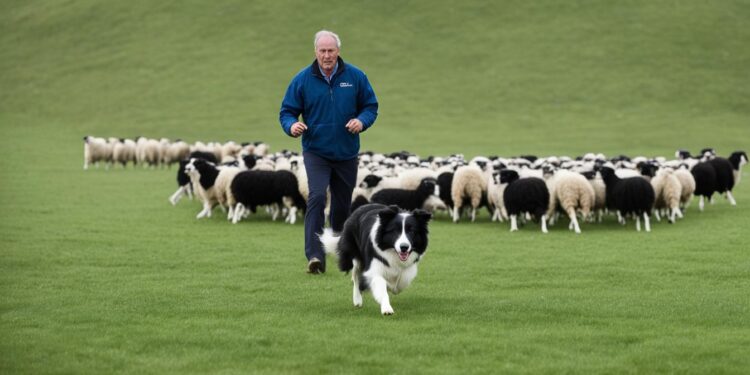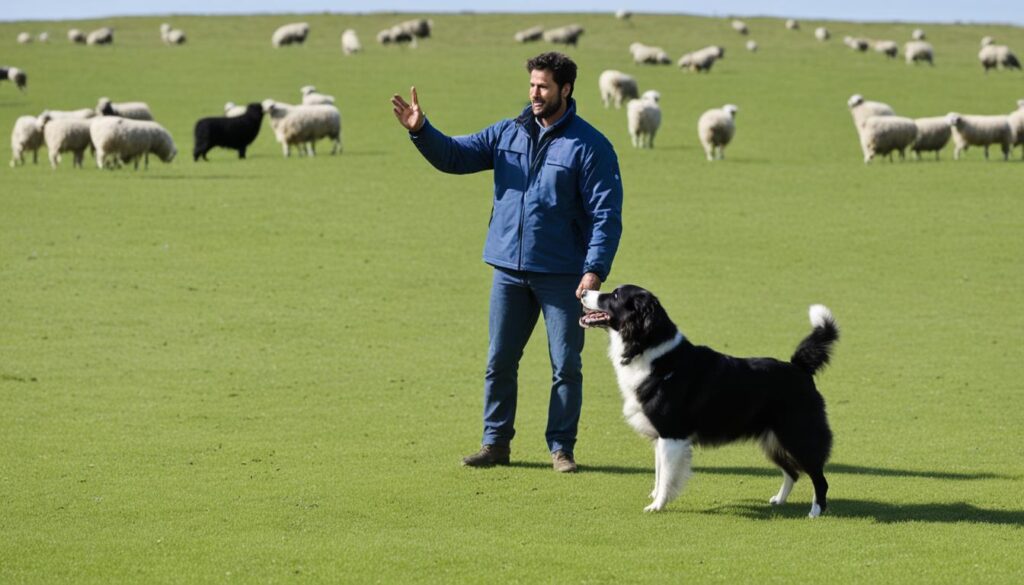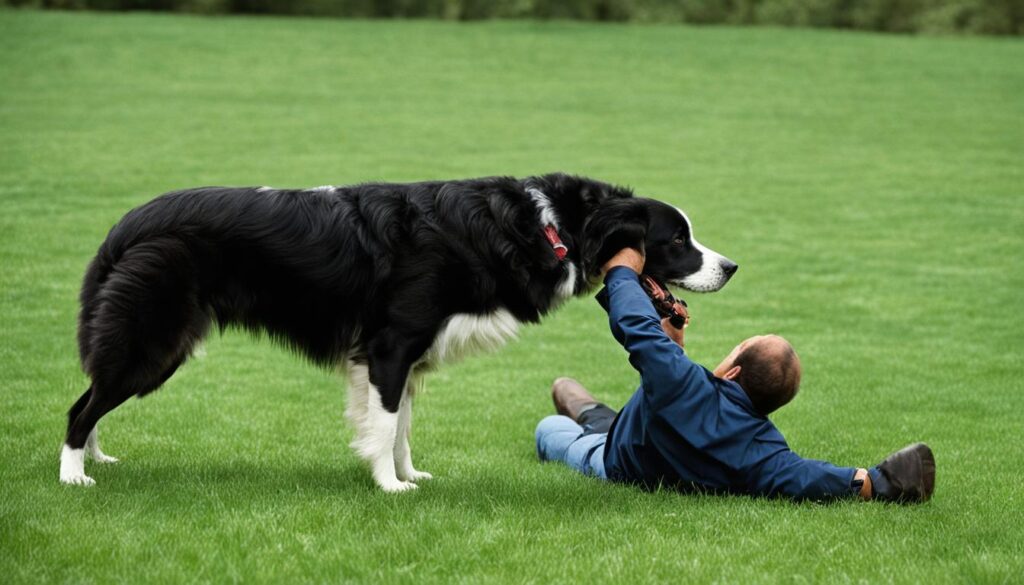Training Techniques for Herding Dogs

Welcome to our article on herding training techniques for working dogs. Herding dogs are known for their exceptional abilities to control and move livestock. However, training these intelligent and energetic breeds requires a breed-specific approach.
Whether you have a Border Collie, Australian Shepherd, or any other herding breed, understanding their unique sensitivities and adapting your training approach is crucial for success. In this article, we will explore effective techniques to address challenges such as picky eating habits, reactive behavior, motion sensitivity, spacial sensitivity, and noise sensitivity in herding dogs.
By tailoring your training methods to the specific needs and characteristics of your herding dog, you can foster engagement, obedience, and a harmonious partnership. Let’s explore the different aspects of herding training and discover techniques that will help you and your four-legged companion thrive.
Overcoming Picky Eating Habits in Herding Dogs
Many herding dogs, like Border Collies and Australian Shepherds, can be picky eaters, which poses challenges during training sessions. These dogs may refuse food rewards, making it difficult for owners to effectively reinforce desired behaviors.
However, it is crucial not to give up on using food rewards as a training tool. Instead, modifying the training scenario can help make it less distracting and encourage picky eaters to be more receptive.
One effective approach is to start with calmer training situations that have minimal distractions. By reducing external stimuli, herding dogs can focus better on the task at hand. Once they become comfortable and consistently respond to commands in these simpler scenarios, gradually introduce more excitement and distractions.
For example, if training a Border Collie to respond to a recall command (“come”), begin in a quiet, controlled environment such as a fenced backyard. Once the dog shows consistent success in this setting, gradually progress to more challenging environments like parks or busy streets.
Similarly, when teaching herding dogs to follow a “down” command, start the training indoors in a calm and familiar space. As they become proficient in following the command indoors, gradually introduce distractions such as toys or other dogs.
Remember, herding dogs are intelligent and require mental stimulation in addition to physical exercise. Using food rewards can be an effective way to engage their minds and motivate them during training.
Training Scenarios for Picky Eaters:
- Start with calmer training situations
- Gradually increase the level of excitement
- Reduce external distractions
- Use familiar environments initially
- Introduce distractions gradually
Training a picky eater requires patience and perseverance. By modifying the training scenario and gradually increasing the level of excitement, herding dogs can overcome their pickiness and become more receptive to food rewards.
Training Scenarios for Picky Eaters
| Training Scenario | Description |
|---|---|
| Calmer Training Situations | Create a quiet and controlled environment with minimal distractions to focus the dog’s attention on the training task. |
| Gradually Increase Excitement | Once the dog responds consistently in calm settings, slowly introduce more excitement and distractions to challenge their focus. |
| Reduce External Distractions | Minimize external stimuli that may divert the dog’s attention away from the training, allowing them to stay focused on the task at hand. |
| Use Familiar Environments Initially | Start training in familiar spaces where the dog feels comfortable, increasing their confidence and willingness to engage in training activities. |
| Introduce Distractions Gradually | Slowly introduce distractions, such as toys or other dogs, to teach the dog to remain focused on the training despite external influences. |
Managing Reactive Behavior in Herding Dogs
Herding breeds are known for their originally suspicious nature, which can manifest as reactive behavior in certain situations. It is crucial to address and manage this behavior to ensure that herding dogs can interact with their environment and other individuals in a well-behaved manner. Socialization and positive exposure play a key role in training herding dogs to be less reactive and more responsive to their surroundings.
Proper socialization involves exposing herding dogs to a variety of people, dogs, places, and sounds from an early age. This helps them develop confidence and adaptability, reducing the likelihood of reactive behavior. Positive exposure, on the other hand, focuses on creating positive associations with specific stimuli that may trigger reactivity. By gradually introducing herding dogs to these stimuli in a controlled and positive manner, they can learn to remain calm and composed.
It is important to note that each herding breed has its own temperament and tendencies. Therefore, understanding the specific needs and characteristics of the breed is essential when planning and implementing strategies to manage reactive behavior. Some herding breeds may require more socialization and exposure than others due to their genetic predispositions.
To sum up, addressing reactive behavior in herding dogs requires a proactive approach that incorporates socialization and positive exposure. By creating positive associations with different stimuli and gradually exposing them to various environments, herding dogs can learn to navigate the world around them with confidence and grace.
Through proper management of reactive behavior, herding dogs can thrive and become valuable companions. The next section will discuss techniques for addressing motion sensitivity in herding dogs, helping them overcome their instinctual drive to control movement and achieve a harmonious coexistence with their owners.
Addressing Motion Sensitivity in Herding Dogs
Motion sensitivity is a common trait in herding dogs due to their instinct to control movement. It is important to address this sensitivity and provide mental stimulation to engage them in alternative activities that do not solely revolve around chasing or following motion. By offering calmer activities, such as food puzzle games, we can redirect their focus and alleviate excessive motion sensitivity.
“Motion sensitivity in herding dogs can range from a heightened awareness of moving objects to an intense desire to chase or control motion,” says Dr. Amanda Roberts, a canine behavior specialist. “To manage this sensitivity and prevent it from becoming problematic, we need to provide mental stimulation and enrichment to keep their minds engaged in activities that do not solely rely on motion-related behaviors.”
Mental stimulation is crucial for herding dogs as it helps satisfy their natural instincts and reduces their likelihood of fixating on motion. Offering alternative activities that challenge their minds can redirect their focus and provide a healthy outlet for their energy.
Mental Stimulation Activities for Herding Dogs
Here are some alternative activities that can provide mental stimulation for herding dogs:
- Food puzzle games: These toys require the dog to solve puzzles to access their treats, keeping their minds engaged and providing a rewarding challenge.
- Scent work: Engaging a herding dog’s sense of smell through scent work activities can provide mental stimulation and help divert their attention from motion.
- Training with commands: Teaching new commands and reinforcing existing ones can provide mental stimulation while enhancing the bond between the dog and its owner.
- Problem-solving challenges: Presenting herding dogs with interactive toys that require them to figure out how to obtain a reward can keep their minds active and focused on a task.
- Hide and seek: Playing hiding games with treats or favorite toys can stimulate a herding dog’s mental faculties and engage their natural hunting instincts.
By incorporating these activities into their daily routine, herding dog owners can help address motion sensitivity while providing mental stimulation.
| Benefits of Alternative Activities for Herding Dogs | Examples of Alternative Activities |
|---|---|
| 1. Mental stimulation: Engaging in alternative activities helps satisfy their instincts and keeps their minds active. | Food puzzle games, scent work, hide and seek |
| 2. Redirection of focus: Calmer activities redirect their attention from motion-related behavior. | Training with commands, problem-solving challenges |
| 3. Energy outlet: Providing mentally stimulating activities can help reduce their energy levels. | Training with commands, interactive toys |
These alternative activities not only address motion sensitivity but also provide herding dogs with mental stimulation, a crucial aspect of their overall well-being.
Overcoming Spacial Sensitivity in Herding Dogs
Herding dogs are known for their spacial sensitivity, which can present challenges when it comes to handling and getting close to them. Whether it’s reaching for their collar or being in their personal space, desensitization training is key to helping them become more comfortable and accepting of these actions.
Desensitization training involves gradually exposing the dog to the triggers that cause spacial sensitivity and pairing them with positive experiences. By doing so, the dog learns to associate these actions with something pleasant, reducing their sensitivity over time.
One effective approach in desensitizing a herding dog to spacial sensitivity is the “getting into the bubble” technique. This technique involves slowly and incrementally invading the dog’s personal space in a non-threatening manner. Start by standing slightly closer to the dog than usual, while staying calm and relaxed. Gradually decrease the distance over multiple sessions, always rewarding the dog with treats, praise, or playtime to reinforce positive associations.
Another important aspect of addressing spacial sensitivity is establishing a positive association with reaching for the collar. Many herding dogs may instinctively try to avoid collar handling, so it’s crucial to make this experience enjoyable for them.
Remember: Patience is key during this training process. Respect the dog’s comfort zone and progress at a pace that they are comfortable with.
A sample desensitization training plan for spacial sensitivity in herding dogs:
| Training Phase | Activities |
|---|---|
| Phase 1: Establishing Positive Association |
|
| Phase 2: Gradual Intrusion |
|
| Phase 3: Collar Touching |
|
Desensitization training requires time, consistency, and positive reinforcement. By helping a herding dog overcome their spacial sensitivity, you’ll create a stronger bond and improve their overall behavior and well-being.
Dealing with Noise Sensitivity in Herding Dogs
Herding dogs, due to their breeding history in quiet environments, can be particularly sensitive to noise. It is essential for owners to address this noise sensitivity in their training approach to ensure a calm and confident dog. A technique that can be effective in reducing noise sensitivity is counterconditioning.
Counterconditioning involves pairing the triggering sounds with positive associations, such as food rewards. This process helps the dog create a positive connection with the previously distressing noises. Consistent exposure to low-intensity sounds, gradually increasing their intensity over time, can also desensitize the dog to the noises that once made them anxious.
By desensitizing herding dogs to noise and creating positive associations, owners can help their dogs become more resilient and less reactive in noisy situations. This enables them to focus on the task at hand and remain calm and attentive.
Benefits of Counterconditioning for Noise Sensitivity
Counterconditioning offers several benefits for addressing noise sensitivity in herding dogs:
- Reduces anxiety: Counterconditioning helps reduce the anxiety and stress that noise sensitivity can cause in herding dogs. By creating positive associations, the dog learns to associate previously distressing sounds with positive experiences, leading to reduced anxiety levels.
- Improves focus and performance: Noise sensitivity can distract herding dogs and affect their performance during training or herding activities. Counterconditioning enables them to maintain focus and perform effectively, even in noisy environments.
- Enhances overall well-being: By overcoming noise sensitivity, herding dogs can experience an enhanced overall sense of well-being. They will be more relaxed and comfortable in various environments, improving their quality of life.
Counterconditioning Process
The counterconditioning process for noise sensitivity involves several steps:
- Identification of triggering sounds: Identify the specific sounds that trigger your herding dog’s anxiety or sensitivity. These may include thunderstorms, fireworks, construction noise, or other loud sounds.
- Starting with low-intensity sounds: Begin by exposing your dog to low-intensity versions of the triggering sounds. This may involve playing recordings of thunderstorms or fireworks at a low volume.
- Pairing sounds with positive rewards: While playing the low-intensity sounds, provide your herding dog with highly valued rewards, such as treats or praise. This creates a positive association between the sounds and enjoyable experiences.
- Gradually increasing sound intensity: Over time, gradually increase the volume or intensity of the triggering sounds. Ensure that the increase is gradual and within your dog’s comfort level. Continuously pair the sounds with positive rewards to reinforce the positive association.
- Generalization: Once your herding dog becomes desensitized to the low-intensity sounds, gradually introduce them to real-life scenarios where the triggering sounds may occur. This helps them generalize their positive associations and remain calm and composed in various noise-related situations.
Consistency and patience are crucial throughout the counterconditioning process. It is important to progress at your dog’s individual pace and avoid pushing them beyond their comfort zone.
By consistently applying counterconditioning techniques and creating positive associations, herding dog owners can help their dogs overcome noise sensitivity and develop a more confident and resilient approach to noisy environments.
Getting Started with Herding Training
Before diving into herding training, it is essential to establish a strong foundation with basic obedience commands. These commands create a solid communication framework between you and your dog, setting the stage for a successful training journey. Obedience commands play a crucial role in guiding herding breeds during various activities and can be effectively combined with signaling and body language cues.
Start with the following basic commands:
- Come: Teach your dog to come to you when called. This command is vital for herding activities and helps maintain control over your dog’s movements.
- Sit: Teach your dog to sit on command. This command provides stability and control, allowing you to manage their behavior during training or other situations.
- Lie Down: Train your dog to lie down on command. This command can be useful when you need them to stay still or remain calm.
- Stay: Teach your dog to stay in one place until released. This command builds self-control and is essential for herding tasks that require precision and focus.
Once your dog has mastered these basic commands, you can progress to herding-specific commands:
- “Come Bye”: A command used to make your dog go in a clockwise direction around the livestock.
- “Away”: A command used to make your dog go in a counterclockwise direction around the livestock.
- “Walk Up”: A command used to make your dog approach the livestock in a controlled manner.
To effectively communicate with your herding dog during training and herding activities, incorporate a combination of hand and whistle signals. These additional signals can enhance your commands and reinforce your body language cues. Consistency and clear communication are key to successful herding dog training.
Sample Hand Signals for Basic Commands:
| Command | Hand Signal |
|---|---|
| Come |  |
| Sit | |
| Lie Down |  |
| Stay |
Remember to be patient, consistent, and reward your herding dog for their efforts. With proper training techniques and clear communication, you can develop a strong connection and effectively guide your herding breed in various activities.
Conclusion
Training herding dogs requires a thorough understanding of their breed-specific traits and sensitivities. Addressing challenges such as picky eating, reactivity, motion sensitivity, spacial sensitivity, and noise sensitivity is crucial in successfully training these intelligent and instinct-driven breeds.
Patience is key when training herding dogs. Consistency in training techniques and approaches is essential to help them understand and retain the desired behaviors. By tailoring the training approach to the specific breed, owners can effectively communicate with and guide their herding dogs.
Remember, each herding breed has its own unique needs and characteristics. To achieve success in herding training, it is important to adapt the training techniques to match the specific breed’s instincts and abilities. With dedication and a breed-specific approach, owners can fulfill their herding dogs’ potential and develop strong bonds built on trust and communication.
FAQ
What are the unique challenges in training herding dogs?
Training a herding dog comes with unique challenges, such as picky eating habits, reactive behavior, motion sensitivity, spacial sensitivity, and noise sensitivity. It is important to address these sensitivities and tailor the training approach to the specific breed.
How can I overcome picky eating habits in my herding dog?
Many herding dogs are picky eaters and may refuse food rewards during training. It is important not to give up and instead modify the training scenario to make it less distracting. Starting with calmer training situations and gradually increasing the level of excitement can help herding dogs become more receptive to food rewards.
How can I manage reactive behavior in my herding dog?
Herding breeds can be prone to reactive behavior due to their originally suspicious nature. Proper socialization and positive exposure to different people, dogs, places, and sounds are essential in training herding dogs to be well-behaved and less reactive. Each herding breed has its own temperament, so it is important to understand and plan accordingly for the specific breed’s needs.
How can I address motion sensitivity in my herding dog?
Motion sensitivity is a common trait in herding dogs due to their instinct to control movement. It is important to provide mental stimulation and engage them in activities that do not solely revolve around chasing or following motion. Calmer activities, such as food puzzle games, can help redirect their focus and alleviate excessive motion sensitivity.
How can I overcome spacial sensitivity in my herding dog?
Herding dogs can exhibit spacial sensitivity, which can make it challenging to reach for their collars or get too close. Desensitization training and positive reinforcement can help them get accustomed to being touched and accepting their owner’s presence in their personal space. It is crucial to establish a positive association with reaching for the collar.
How can I deal with noise sensitivity in my herding dog?
Herding dogs can be sensitive to noise due to their breeding history in quiet environments. Counterconditioning techniques, such as pairing the triggering sounds with food rewards, can help them overcome their noise sensitivity. Consistent exposure to low-intensity sounds and gradually increasing the intensity can desensitize them and create positive associations.
What should I do to get started with herding training?
Before diving into herding training, it is important to start with basic obedience commands. These commands include “come,” “sit,” “lie down,” and “stay.” Training should progress to herding-specific commands, such as “come bye,” “away,” and “walk up.” Hand and whistle signals can also be used to communicate with the dog during herding activities.
What are the key points in training herding dogs?
Training herding dogs requires an understanding of their breed-specific traits and sensitivities. By addressing challenges like picky eating, reactivity, motion sensitivity, spacial sensitivity, and noise sensitivity, owners can successfully train their herding dogs. Patience, consistency, and tailoring the training approach to the specific breed are key to achieving success in herding training.






